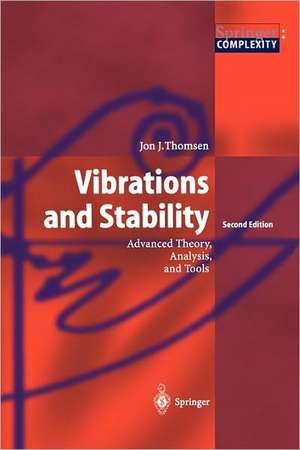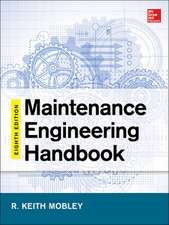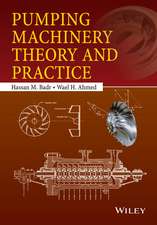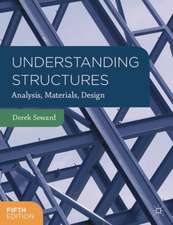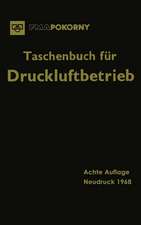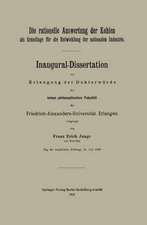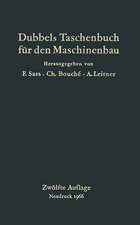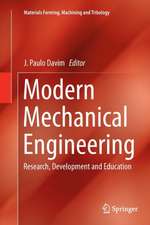Vibrations and Stability: Advanced Theory, Analysis, and Tools
Autor Jon Juel Thomsenen Limba Engleză Paperback – 29 noi 2010
| Toate formatele și edițiile | Preț | Express |
|---|---|---|
| Paperback (2) | 459.87 lei 38-44 zile | |
| Springer Berlin, Heidelberg – 29 noi 2010 | 459.87 lei 38-44 zile | |
| Springer International Publishing – 19 mar 2022 | 596.36 lei 6-8 săpt. | |
| Hardback (2) | 653.14 lei 6-8 săpt. | |
| Springer Berlin, Heidelberg – 11 sep 2003 | 653.14 lei 6-8 săpt. | |
| Springer International Publishing – 19 mar 2021 | 744.99 lei 6-8 săpt. |
Preț: 459.87 lei
Preț vechi: 567.74 lei
-19% Nou
Puncte Express: 690
Preț estimativ în valută:
87.100€ • 92.18$ • 72.93£
87.100€ • 92.18$ • 72.93£
Carte tipărită la comandă
Livrare economică 04-10 aprilie
Preluare comenzi: 021 569.72.76
Specificații
ISBN-13: 9783642072727
ISBN-10: 3642072720
Pagini: 428
Dimensiuni: 155 x 235 x 22 mm
Greutate: 0.59 kg
Ediția:Softcover reprint of hardcover 2nd ed. 2004
Editura: Springer Berlin, Heidelberg
Colecția Springer
Locul publicării:Berlin, Heidelberg, Germany
ISBN-10: 3642072720
Pagini: 428
Dimensiuni: 155 x 235 x 22 mm
Greutate: 0.59 kg
Ediția:Softcover reprint of hardcover 2nd ed. 2004
Editura: Springer Berlin, Heidelberg
Colecția Springer
Locul publicării:Berlin, Heidelberg, Germany
Public țintă
GraduateDescriere
'Vibrations
and
Stability'
is
aimed
at
third
to
fifth-year
undergraduates
and
post
graduates
in
mechanical
or
structural
engineering.
The
book
covers
a
range
of
subjects
relevant
for
a
one-or
two-semester
course
in
advanced
vibrations
and
stability.
Also,
it
can
be
used
for
self-study,
e.
g.
,
by
students
on
master
or
PhD
projects,
researchers,
and
professional
engineers.
The
focus
is
on
nonlinear
phe
nomena
and
tools,
covering
the
themes
of
local
perturbation
analysis
(Chaps.
3
and
4),
bifurcation
analysis
(Chap.
5),
global
analysis
I
chaos
theory
(Chap.
6),
and
special
high-frequency
effects
(Chap.
7).
The
ground
for
nonlinear
analysis
is
laid
with
a
brief
summary
of
elementary
linear
vibration
theory
(Chap.
1),
and
a
treatment
of
differential
eigenvalue
problems
in
some
depth
(Chap.
2).
Also,
there
are
exercise
problems
and
extensive
bibliographic
references
to
serve
the
needs
of
both
students
and
more
experienced
users;
major
exercises
for
course-work;
and
appendices
on
numerical
simulation,
standard
mathematical
formulas,
vibration
properties
of
basic
structural
elements,
and
properties
of
engineering
materials.
This
Second
Edition
is
a
revised
and
expanded
version
of
the
first
edition
(pub
lished
by
McGraw-Hill
in
1997),
reflecting
the
experience
gathered
during
its
now
six
years
in
service
as
a
classroom
or
self-study
text
for
students
and
researchers.
The
second
edition
contains
a
major
new
chapter
(7),
three
new
appendices,
many
new
exercise
problems,
more
than
120
new
and
updated
bibliographic
references,
and
hundreds
of
minor
updates,
corrections,
and
clarifications.
Cuprins
1
Vibration
Basics.-
2
Eigenvalue
Problems
of
Vibrations
And
Stability.-
3
Nonlinear
Vibrations:
Classical
Local
Theory.-
4
Nonlinear
Multiple-DOF
Systems:
Local
Analysis.-
5
Bifurcations.-
6
Chaotic
Vibrations.-
7
Special
Effects
of
High-Frequency
Excitation.-
Appendix
A
—
Performing
Numerical
Simulations.-
A.1
Solving
Differential
Equations.-
A.2
Computing
Chaos-Related
Quantities.-
A.3
Interfacing
with
the
ODE-Solver.-
A.4
Locating
Software
on
the
Internet.-
Appendix
B
—
Major
Exercises.-
B.1
Tension
Control
of
Rotating
Shafts.-
B.1.1
Mathematical
Model.-
B.1.2
Eigenvalue
Problem,
Natural
Frequencies
and
Mode
Shapes.-
B.1.3
Discretisations,
Choice
of
Control
Law.-
B.1.5
Quantitative
Analysis
of
the
Controlled
System.-
B.1.6
Using
a
Dither
Signal
for
Open-Loop
Control.-
B.1.7
Numerical
Analysis
of
the
Controlled
System.-
B.1.8
Conclusions.-
B.2
Vibrations
of
a
Spring-Tensioned
Beam.-
B.2.1
Mathematical
Model.-
B.2.2
Eigenvalue
Problem,
Natural
Frequencies
and
Mode
Shapes.-
B.2.3
Discrete
Models.-
B.2.4
Local
Bifurcation
Analysis
for
the
Unloaded
System.-
B.2.5
Quantitative
Analysis
of
the
Loaded
System.-
B.2.6
Numerical
Analysis.-
B.2.7
Conclusions.-
B.3
Dynamics
of
a
Microbeam.-
B.3.1
System
Description.-
B.3.2
Mathematical
Model.-
B.3.3
Eigenvalue
Problem,
Natural
Frequencies
and
Mode
Shapes.-
B.3.4
Discrete
Models,
Mode
Shape
Expansion.-
B.3.5
Local
Bifurcation
Analysis
for
the
Statically
Loaded
System.-
B.3.6
Quantitative
Analysis
of
the
Loaded
System.-
B.3.7
Numerical
Analysis.-
B.3.8
Conclusions.-
Appendix
C
—
Mathematical
Formulas.-
C.1
Formulas
Typically
Used
in
Perturbation
analysis.-
C.1.1
Complex
Numbers.-
C.1.2
Powers
of
Two-Term
Sums.-
C.1.3
Dirac’s
Delta
Function
(?).-
C.1.4
Averaging
Integrals.-
C.1.5
Fourier
Series
of
a
Periodic
Function.-
C.2
Formulas
for
Stability
Analysis.-
C.2.1
The
Routh-Hurwitz
Criterion.-
C.2.2
Mathieu’s
Equation:Stability
of
the
Zero-Solution.-
Appendix
D
—
Vibration
Modes
and
Frequencies
for
Structural
Elements.-
D.1
Rods.-
D.1.1
Longitudinal
Vibrations.-
D.1.2
Torsional
Vibrations.-
D.2
Beams.-
D.2.1
Bernoulli-Euler
Theory.-
D.2.2
Timoshenko
Theory.-
D.3
Rings.-
D.3.1
In-Plane
Bending.-
D.3.2
Out-of-Plane
Bending.-
D.3.3
Extension.-
D.4
Membranes.-
D.4.1
Rectangular
Membrane.-
D.4.2
Circular
Membrane.-
D.5
Plates.-
D.5.1
Rectangular
Plate.-
D.5.2
Circular
Plate.-
D.6
Other
Structures.-
Appendix
E
—
Properties
of
Engineering
Materials.-
E.1
Friction
and
Thermal
Expansion
Coefficients.-
E.2
Density
and
Elasticity
Constants.-
References.
Recenzii
From
the
reviews
of
the
second
edition:
"Vibrations and stability … attracted a vast amount of attention of a multitude of researchers in the past and present and will remain highly topical in the future. … The 2nd edition of the book, a thoroughly revised and expanded version of the 1st edition, is an essential by-product of this evolution. … In the reviewer’s opinion the author … has written a highly recommendable book. I am very pleased to review the book. … It presents a very readable and well-structured account … ." (Dr C. B. Sharma, Contemporary Physics, Vol. 45 (6), 2004)
"The second edition of ‘Vibrations and Stability’ is an accomplished and valuable book, mainly devoted to vibrations in the non-linear regime. … It is a pleasure to read this clearly written book, which achieves the aim of presenting important material on non-linear vibrations in a useful and quite understandable manner. … relevant references are given for readers interested in more information. … Engineers, researchers, and particularly students and teachers in mechanical and structural engineering will find this to be a very helpful book." (Pedro Ribeiro, Journal of Sound and Vibration, Vol. 274 (4-5), 2004)
"Every chapter is equipped with useful exercises. The reviewed book will be very useful in engineering and scientific practice." (Boris V. Loginov, Zentralblatt MATH, Vol. 1086, 2006)
"Vibrations and stability … attracted a vast amount of attention of a multitude of researchers in the past and present and will remain highly topical in the future. … The 2nd edition of the book, a thoroughly revised and expanded version of the 1st edition, is an essential by-product of this evolution. … In the reviewer’s opinion the author … has written a highly recommendable book. I am very pleased to review the book. … It presents a very readable and well-structured account … ." (Dr C. B. Sharma, Contemporary Physics, Vol. 45 (6), 2004)
"The second edition of ‘Vibrations and Stability’ is an accomplished and valuable book, mainly devoted to vibrations in the non-linear regime. … It is a pleasure to read this clearly written book, which achieves the aim of presenting important material on non-linear vibrations in a useful and quite understandable manner. … relevant references are given for readers interested in more information. … Engineers, researchers, and particularly students and teachers in mechanical and structural engineering will find this to be a very helpful book." (Pedro Ribeiro, Journal of Sound and Vibration, Vol. 274 (4-5), 2004)
"Every chapter is equipped with useful exercises. The reviewed book will be very useful in engineering and scientific practice." (Boris V. Loginov, Zentralblatt MATH, Vol. 1086, 2006)
Textul de pe ultima copertă
This
book
ties
together
classical
and
modern
topics
of
advanced
vibration
analysis
in
an
interesting
and
lucid
manner.
It
provides
students
with
a
background
in
elementary
vibrations,
with
tools
necessary
for
understanding
and
analyzing
more
complex
dynamical
phenomena
that
can
be
encountered
in
engineering
and
scientific
practice.
It
progresses
steadily
from
linear
vibration
theory
over
various
levels
of
nonlinearity
to
bifurcation
analysis,
global
dynamics
and
chaotic
vibrations.
It
trains
the
student
to
analyze
simple
models,
recognize
nonlinear
phenomena
and
work
with
advanced
tools
such
as
perturbation
analysis
and
bifurcation
analysis.
Explainig
theory
in
terms
of
relevant
examples
from
real
systems,
this
book
is
user-
friendly
and
meets
the
increasing
interest
in
non-linear
dynamics
in
mechanical/structural
engineering
and
applied
mathematics
and
physics.
The
new
revised
and
updated
edition
includes
a
new
chapter
on
useful
effects
of
fast
vibrations
and
many
new
exercise
problems.
Caracteristici
Complex
systems
made
simple
Notă biografică
PhD (1988) and dr.techn. (2003) in mechanical vibrations and dynamics; associate professor at the Technical University of Denmark, Dept. of Mechanical Engineering. Author of 100+ peer reviewed scientific publications, covering many aspects of theoretical and experimental vibration analysis, in particular nonlinear effects and analysis. 30+ years of university teaching in advanced and basic vibration theory, dynamics, computer modeling, and experimental mechanics. Fundamental and applied research with a special focus on the description, analysis and synthesis of nonlinear phenomena, e.g. vibration suppression using nonlinearity, object transport using vibrations, non-trivial effects of high-frequency excitation, deterministic chaos, wave propagation in periodic media, discontinuous processes (e.g. vibro-impact, friction, clearance), fluid flow affected vibrations, vibration analysis for non-destructive testing and structural health monitoring, and nonlinear modal interaction; see more on www.staff.dtu.dk/jjth.
